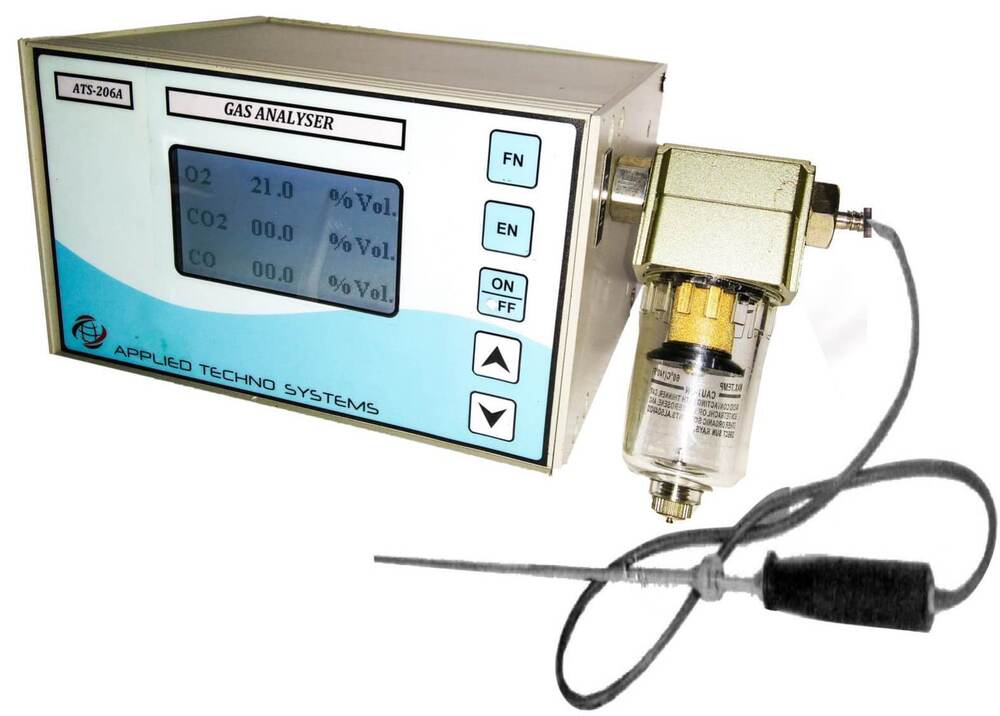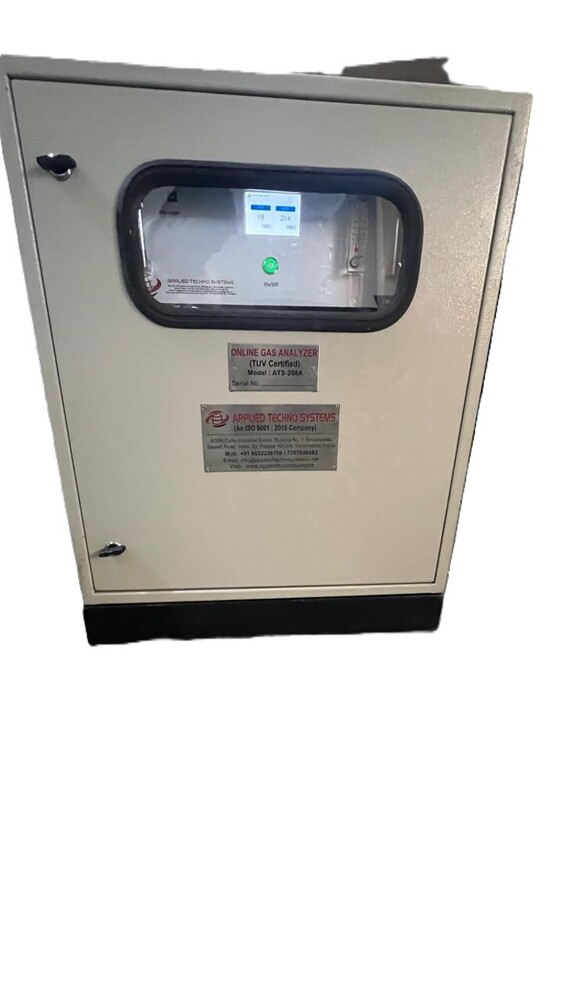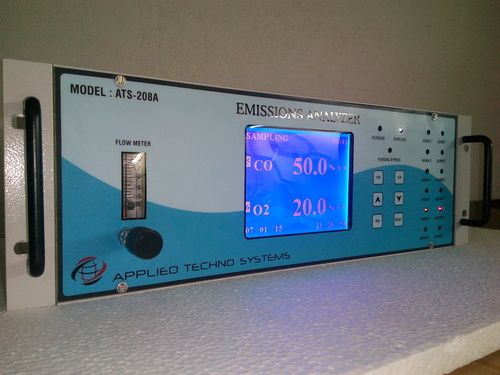- Dew Point Meters
- Gas Analysers
- Portable Gas Detector
- Moisture And Dew Point Analyzer
- Dust/Opacity Monitor
- Gas Monitoring Systems
- Gas Leak Detectors
- Gas Transmitters
- VOC Leak Detector
- Air Quality Monitoring System
- Online Continuous Emission Monitoring System-OCEMS
- Dew Point Monitors
- Gas Detector
- Opacity Monitor
- Portable Flue Gas Analyzer
- Online SOX & NOX Gas Analyzer
- Methane Gas Leak Detector
- Hydrogen Purity Analyzer
- Gas Purity Analyzer
- Effluent Monitoring Systems
- Producer Gas Analyzer
- Gas Detector Calibration Service
- Portable Gas Monitors
- Gas Sensor Transmitter
ATS Portable Flue Gas Analyzer Model ATS206A
Price 185000 INR/ Unit
ATS Portable Flue Gas Analyzer Model ATS206A Specification
- Voltage
- 110-215 Volt (v)
- Automation Grade
- Semi-automatic
- Hardness
- Yes
- Features
- Good Quality
- Product Type
- Flue Gas Analyzer
- Operate Method
- Semi Automatic
- Material
- MS
- Mounting Type
- Handheld or tripod
- Usage
- Industrial
- Control Mode
- Manual
ATS Portable Flue Gas Analyzer Model ATS206A Trade Information
- Minimum Order Quantity
- 1 Unit
- Supply Ability
- 1000 Units Per Month
- Delivery Time
- 7 Days
About ATS Portable Flue Gas Analyzer Model ATS206A
Gas Probes & Sampling System -Flue gas sampling probes with different lengths, shapes and max, operating temperatures Up to 1600C are available to match various requirements of different applications. A sintered pre-filter is suggested for severe and having dust loaded applications.OPERATION-On start up, the instrument automatically goes through complete integrity check, calibration cycle before displaying its readings for sampling. With the press of sampling switch, the analyzer automatically extracts the sample, analyses and display the concentrations of various gases in cyclic order. To stop or for further sampling at different locations or clearing with fresh air before switch off, one has to press the sample switch again.
Applications-
In Quality Control Labs
Process Analysis
Stack Gas Analysis
Fuel Efficiency Analysis
Furnaces Diesel/Petrol Exhaust Emission
Engine Exhaust Emission
Internal Combustion Engines
Burner Performance Monitoring
Boiler Corrosion
Ambient & Emission Monitoring
Atmosphere Monitoring
Burner Flame Control
Underground Mines
Excess Air Measurement
Specifications -
| Accuracy : +/-2%. Display : High quality 128 x 64 Graphics LCD. Sampling : Auto Suction Sampling through Inbuilt Pump Zero Calibration: Automatic at instrument start up with fresh air sample. Power Supply : Internal Battery Pack with external Charger 230V / 50 Hz Response Time: 30 seconds at 95% variation. Sampling probe up to 1200 Deg C Response Time: Maximum 20 Second at 95% variation Storage Temp: -20 to 45 deg C |
Durable Industrial Design
The ATS206A analyzer features a sturdy mild steel construction, making it suitable for demanding industrial environments. Its rugged handheld or tripod-mounted configuration ensures adaptability across different usage scenarios, providing both mobility and stability during measurements.
Precise and Manual Control
This flue gas analyzer is engineered with a manual control mode, allowing operators to fine-tune measurements according to specific requirements. The semi-automatic operation provides a manageable balance between automation and user involvement, optimizing accuracy and process oversight.
FAQs of ATS Portable Flue Gas Analyzer Model ATS206A:
Q: How does the ATS206A Portable Flue Gas Analyzer operate?
A: The ATS206A operates in a semi-automatic mode, requiring manual control for calibration and measurement. It is powered by an electrical input ranging from 110 to 215 volts, and can be used either handheld for portable applications or mounted on a tripod for stability.Q: What are the main benefits of using the ATS206A in industrial settings?
A: This analyzer offers reliable flue gas measurements in a wide variety of industrial applications. Its robust MS construction, adaptable mounting options, and precision control ensure accurate data collection, supporting process optimization and compliance with emission standards.Q: When is it recommended to use the ATS206A Flue Gas Analyzer?
A: The ATS206A is recommended whenever precise and periodic monitoring of industrial flue gases is required. It is ideal for routine emissions checks, maintenance activities, and troubleshooting processes within industrial plants.Q: Where can the ATS206A be utilized?
A: This analyzer is designed for use in industrial environments across India, whether in manufacturing plants, power generation facilities, or other industrial sites where flue gas analysis is essential for safety and regulatory compliance.Q: What is the process for setting up and using the ATS206A analyzer?
A: To use the ATS206A, simply connect it to a compatible power supply (110-215V), decide on handheld or tripod-mounted operation, and follow the manual calibration procedures. The semi-automatic design guides the operator through sampling and analysis steps.Q: How can using this analyzer benefit industrial operations?
A: By providing quick and accurate analysis of flue gases, the ATS206A helps industries monitor and manage emissions, optimize combustion efficiency, and ensure adherence to regulatory requirements, ultimately safeguarding both operational efficiency and environmental standards.

Price:
- 50
- 100
- 200
- 250
- 500
- 1000+
More Products in Gas Analysers Category
Exhaust Gas Analyzers
Price 158000 INR / Unit
Minimum Order Quantity : 1 Unit
Power Supply : Electric
Humidity : < 85%RH
Material : Mild Steel
Usage : Industrial
Flue Efficiency Gas Analyzer
Price 72500 INR / Pack
Minimum Order Quantity : 1 Pack
Power Supply : Electric
Humidity : < 85%RH
Material : ABS plastic
Usage : Industrial
Online Stack Gas Analyzers
Price 418500 INR / Set
Minimum Order Quantity : 1 Set
Power Supply : Electric
Humidity : < 85%RH
Confined Space Oxygen Gas Leak Monitor
Price 30000 INR / Number
Minimum Order Quantity : 1 Number
Power Supply : Electric
Humidity : < 85%RH
Material : ABS Plastic
Usage : Industrial

 Send Inquiry
Send Inquiry





 English
English Spanish
Spanish French
French German
German Italian
Italian Chinese (Simplified)
Chinese (Simplified) Japanese
Japanese Korean
Korean Arabic
Arabic Portuguese
Portuguese